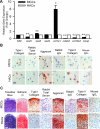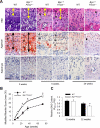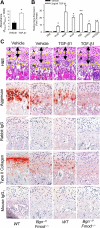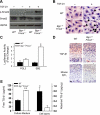Biglycan and fibromodulin have essential roles in regulating chondrogenesis and extracellular matrix turnover in temporomandibular joint osteoarthritis
- PMID: 20035055
- PMCID: PMC2808087
- DOI: 10.2353/ajpath.2010.090450
Biglycan and fibromodulin have essential roles in regulating chondrogenesis and extracellular matrix turnover in temporomandibular joint osteoarthritis
Abstract
The temporomandibular joint is critical for jaw movements and allows for mastication, digestion of food, and speech. Temporomandibular joint osteoarthritis is a degenerative disease that is marked by permanent cartilage destruction and loss of extracellular matrix (ECM). To understand how the ECM regulates mandibular condylar chondrocyte (MCC) differentiation and function, we used a genetic mouse model of temporomandibular joint osteoarthritis that is deficient in two ECM proteins, biglycan and fibromodulin (Bgn(-/0)Fmod(-/-)). Given the unavailability of cell lines, we first isolated primary MCCs and found that they were phenotypically unique from hyaline articular chondrocytes isolated from the knee joint. Using Bgn(-/0) Fmod(-/-) MCCs, we discovered the early basis for temporomandibular joint osteoarthritis arises from abnormal and accelerated chondrogenesis. Transforming growth factor (TGF)-beta1 is a growth factor that is critical for chondrogenesis and binds to both biglycan and fibromodulin. Our studies revealed the sequestration of TGF-beta1 was decreased within the ECM of Bgn(-/0) Fmod(-/-) MCCs, leading to overactive TGF-beta1 signal transduction. Using an explant culture system, we found that overactive TGF-beta1 signals induced chondrogenesis and ECM turnover in this model. We demonstrated for the first time a comprehensive study revealing the importance of the ECM in maintaining the mandibular condylar cartilage integrity and identified biglycan and fibromodulin as novel key players in regulating chondrogenesis and ECM turnover during temoporomandibular joint osteoarthritis pathology.
Figures






Similar articles
-
Mice deficient in biglycan and fibromodulin as a model for temporomandibular joint osteoarthritis.Cells Tissues Organs. 2005;181(3-4):136-43. doi: 10.1159/000091375. Cells Tissues Organs. 2005. PMID: 16612079
-
Analysis of microarchitectural changes in a mouse temporomandibular joint osteoarthritis model.Arch Oral Biol. 2009 Dec;54(12):1091-8. doi: 10.1016/j.archoralbio.2009.10.001. Epub 2009 Nov 6. Arch Oral Biol. 2009. PMID: 19896116 Free PMC article.
-
Extracellular Matrix Mediates BMP-2 in a Model of Temporomandibular Joint Osteoarthritis.Cells Tissues Organs. 2017;204(2):84-92. doi: 10.1159/000464102. Epub 2017 Apr 19. Cells Tissues Organs. 2017. PMID: 28419987 Free PMC article.
-
Pathological mechanism of chondrocytes and the surrounding environment during osteoarthritis of temporomandibular joint.J Cell Mol Med. 2021 Jun;25(11):4902-4911. doi: 10.1111/jcmm.16514. Epub 2021 May 5. J Cell Mol Med. 2021. PMID: 33949768 Free PMC article. Review.
-
Cartilage proteoglycans.Semin Cell Dev Biol. 2001 Apr;12(2):69-78. doi: 10.1006/scdb.2000.0243. Semin Cell Dev Biol. 2001. PMID: 11292372 Review.
Cited by
-
A time-dependent degeneration manner of condyle in rat CFA-induced inflamed TMJ.Am J Transl Res. 2016 Feb 15;8(2):556-67. eCollection 2016. Am J Transl Res. 2016. PMID: 27158347 Free PMC article.
-
A proteomic profile of synoviocyte lesions microdissected from formalin-fixed paraffin-embedded synovial tissues of rheumatoid arthritis.Clin Proteomics. 2015 Aug 6;12(1):20. doi: 10.1186/s12014-015-9091-8. eCollection 2015. Clin Proteomics. 2015. PMID: 26251654 Free PMC article.
-
Biglycan: a multivalent proteoglycan providing structure and signals.J Histochem Cytochem. 2012 Dec;60(12):963-75. doi: 10.1369/0022155412456380. Epub 2012 Jul 20. J Histochem Cytochem. 2012. PMID: 22821552 Free PMC article. Review.
-
Proteoglycans in health and disease: novel regulatory signaling mechanisms evoked by the small leucine-rich proteoglycans.FEBS J. 2010 Oct;277(19):3864-75. doi: 10.1111/j.1742-4658.2010.07797.x. Epub 2010 Aug 31. FEBS J. 2010. PMID: 20840584 Free PMC article. Review.
-
A novel approach to establishing a temporomandibular joint fibrocartilage cell line.J Dent Sci. 2022 Jul;17(3):1378-1386. doi: 10.1016/j.jds.2022.04.017. Epub 2022 May 12. J Dent Sci. 2022. PMID: 35784155 Free PMC article.
References
-
- Scrivani SJ, Keith DA, Kaban LB. Temporomandibular disorders. N Engl J Med. 2008;359:2693–2705. - PubMed
-
- Zarb GA, Carlsson GE. Temporomandibular disorders: osteoarthritis. J Orofac Pain. 1999;13:295–306. - PubMed
-
- Bosshardt-Luehrs CP, Luder HU. Cartilage matrix production and chondrocyte enlargement as contributors to mandibular condylar growth in monkeys (Macaca fascicularis). Am J Orthod Dentofacial Orthop. 1991;100:362–369. - PubMed
-
- Meikle MC. Remodeling the dentofacial skeleton: the biological basis of orthodontics and dentofacial orthopedics. J Dent Res. 2007;86:12–24. - PubMed
-
- Almarza AJ, Athanasiou KA. Design characteristics for the tissue engineering of cartilaginous tissues. Ann Biomed Eng. 2004;32:2–17. - PubMed
Publication types
MeSH terms
Substances
Grants and funding
LinkOut - more resources
Full Text Sources
Medical
Molecular Biology Databases
Miscellaneous

